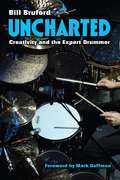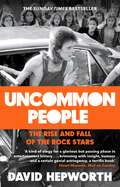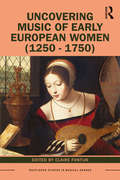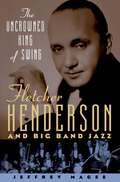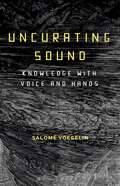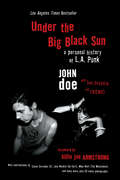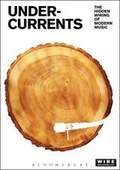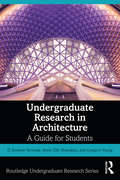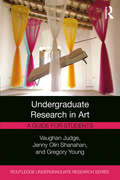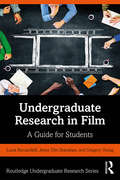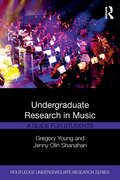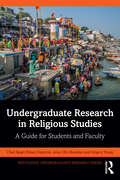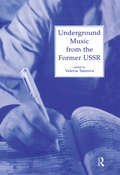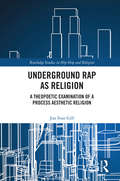- Table View
- List View
Uncharted: Creativity and the Expert Drummer (Tracking Pop)
by Bill BrufordWhat do expert drummers do? Why do they do it? Is there anything creative about it? If so, how might that creativity inform their practice and that of others in related artistic spheres? Applying ideas from cultural psychology to findings from research into the creative behaviors of a specific subset of popular music instrumentalists, Bill Bruford demonstrates the ways in which expert drummers experience creativity in performance and offers fresh insights into in-the-moment interactional processes in music. An expert practitioner himself, Dr. Bruford draws on a cohort of internationally renowned, peak-career professionals and his own experience to guide the reader through the many dimensions of creativity in drummer performance.
Uncommon People: The Rise and Fall of the Rock Stars 1955-1994
by David HepworthAs heard on BBC 6 Music with Shaun Keveny, BBC Radio 5 Live and Talk Radio with Eamonn HolmesThe age of the rock star, like the age of the cowboy, has passed. Like the cowboy, the idea of the rock star lives on in our imaginations.What did we see in them? Swagger. Recklessness. Sexual charisma. Damn-the-torpedoes self-belief. A certain way of carrying themselves. Good hair. Interesting shoes. Talent we wished we had.What did we want of them? To be larger than life but also like us. To live out their songs. To stay young forever. No wonder many didn’t stay the course.In Uncommon People, David Hepworth zeroes in on defining moments and turning points in the lives of forty rock stars from 1955 to 1995, taking us on a journey to burst a hundred myths and create a hundred more. As this tribe of uniquely motivated nobodies went about turning themselves into the ultimate somebodies, they also shaped us, our real lives and our fantasies. Uncommon People isn’t just their story. It’s ours as well.
Unconditional Love
by Howard GoodallUnconditional Love is Howard Goodall’s heartfelt cantata of gratitude and remembrance, a poignant reflection upon the COVID-19 crisis. It seeks both to give thanks to those who sacrificed their lives in the aid of others and to offer solace to the grieving. Yet unifying each of its seven movements is a call to hope and to moving forward in a world rebuilt. The cantata commemorates the selflessness and togetherness felt by communities across the world during the pandemic, communities that offer their thanksgiving in many different ways. It is hoped that Unconditional Love’s universal messages will resonate with choirs of all kinds and in all places, for many years to come. The front cover features the iconic painting, ‘The Hug’, by the artist Charlie Mackesy. Written for soprano solo, SATB choir, piano, organ and brass ensemble, this vocal score includes a piano rehearsal part.
Uncovering Music of Early European Women (1250-1750)
by Claire FontijnUncovering Music of Early European Women (1250 – 1750) brings together nine chapters that investigate aspects of female music-making and musical experience in the medieval and early modern periods. Part I, "Notes from the Underground," treats the spirituality of women in solitude and in community. Parts II and III, "Interlude" and "Music for Royal Rivals," respond to Joan Kelly’s famous feminist question and suggest that women of a certain stature did have a Renaissance. Part IV, "Serenissime Sirene," plays with the notion of the allure of music and its risks in Venice during the Baroque. The process of uncovering requires close listening to women’s creative endeavors in an ongoing effort to piece together equitably the terrain of early music. Contributors include: Cynthia J. Cyrus, Claire Fontijn, Catherine E. Gordon, Laura Jeppesen, Eva Kuhn, Anne MacNeil, Jason Stoessel, Elizabeth Randell Upton, and Laurence Wuidar. An invaluable book for college students and scholars interested in the social and cultural meanings of women in early music.
Uncovering Music of Early European Women (1250-1750)
by Claire FontijnUncovering Music of Early European Women (1250 – 1750) brings together nine chapters that investigate aspects of female music-making and musical experience in the medieval and early modern periods. Part I, "Notes from the Underground," treats the spirituality of women in solitude and in community. Parts II and III, "Interlude" and "Music for Royal Rivals," respond to Joan Kelly’s famous feminist question and suggest that women of a certain stature did have a Renaissance. Part IV, "Serenissime Sirene," plays with the notion of the allure of music and its risks in Venice during the Baroque. The process of uncovering requires close listening to women’s creative endeavors in an ongoing effort to piece together equitably the terrain of early music. Contributors include: Cynthia J. Cyrus, Claire Fontijn, Catherine E. Gordon, Laura Jeppesen, Eva Kuhn, Anne MacNeil, Jason Stoessel, Elizabeth Randell Upton, and Laurence Wuidar. An invaluable book for college students and scholars interested in the social and cultural meanings of women in early music.
The Uncrowned King of Swing: Fletcher Henderson and Big Band Jazz
by Jeffrey MageeIf Benny Goodman was the "King of Swing," then Fletcher Henderson was the power behind the throne. Now Jeffrey Magee offers a fascinating account of Henderson's musical career, throwing new light on the emergence of modern jazz and the world that created it. Drawing on an unprecedented combination of sources, including sound recordings and hundreds of scores that have been available only since Goodman's death, Magee illuminates Henderson's musical output, from his early work as a New York bandleader, to his pivotal role in building the Kingdom of Swing. He shows how Henderson, standing at the forefront of the New York jazz scene during the 1920s and '30s, assembled the era's best musicians, simultaneously preserving jazz's distinctiveness and performing popular dance music that reached a wide audience. Magee reveals how, in Henderson's largely segregated musical world, black and white musicians worked together to establish jazz, how Henderson's style rose out of collaborations with many key players, how these players deftly combined improvised and written music, and how their work negotiated artistic and commercial impulses. Whether placing Henderson's life in the context of the Harlem Renaissance or describing how the savvy use of network radio made the Henderson-Goodman style a national standard, Jeffrey Magee brings to life a monumental musician who helped to shape an era. "An invaluable survey of Henderson's life and music." --Don Heckman, Los Angeles Times "Magee has written an important book, illuminating an era too often reduced to its most familiar names. Goodman might have been the King of Swing, but Henderson here emerges as that kingdom's chief architect." --Boston Globe "Excellent.... Jazz fans have waited 30 years for a trained musicologist...to evaluate Henderson's strengths and weaknesses and attempt to place him in the history of American music." --Will Friedwald, New York Sun
The Uncrowned King of Swing: Fletcher Henderson and Big Band Jazz
by Jeffrey MageeIf Benny Goodman was the "King of Swing," then Fletcher Henderson was the power behind the throne. Now Jeffrey Magee offers a fascinating account of Henderson's musical career, throwing new light on the emergence of modern jazz and the world that created it. Drawing on an unprecedented combination of sources, including sound recordings and hundreds of scores that have been available only since Goodman's death, Magee illuminates Henderson's musical output, from his early work as a New York bandleader, to his pivotal role in building the Kingdom of Swing. He shows how Henderson, standing at the forefront of the New York jazz scene during the 1920s and '30s, assembled the era's best musicians, simultaneously preserving jazz's distinctiveness and performing popular dance music that reached a wide audience. Magee reveals how, in Henderson's largely segregated musical world, black and white musicians worked together to establish jazz, how Henderson's style rose out of collaborations with many key players, how these players deftly combined improvised and written music, and how their work negotiated artistic and commercial impulses. Whether placing Henderson's life in the context of the Harlem Renaissance or describing how the savvy use of network radio made the Henderson-Goodman style a national standard, Jeffrey Magee brings to life a monumental musician who helped to shape an era. "An invaluable survey of Henderson's life and music." --Don Heckman, Los Angeles Times "Magee has written an important book, illuminating an era too often reduced to its most familiar names. Goodman might have been the King of Swing, but Henderson here emerges as that kingdom's chief architect." --Boston Globe "Excellent.... Jazz fans have waited 30 years for a trained musicologist...to evaluate Henderson's strengths and weaknesses and attempt to place him in the history of American music." --Will Friedwald, New York Sun
Uncurating Sound: Knowledge with Voice and Hands
by Salomé VoegelinUncurating Sound performs, across five chapters, a deliberation between art, politics, knowledge and normativity. It foregrounds the perfidy of norms and engages in the curatorial as a colonial knowledge project, whose economy of exploitation draws a straight line from Enlightenment's desire for objectivity, through sugar, cotton and tobacco, via lives lost and money made to the violence of contemporary art.It takes from curation the notion of care and thinks it through purposeful inefficiency as resistance: going sideways and another way. Thus it moves curation through the double negative of not not to “uncuration”: untethering knowledge from the expectations of reference and a canonical frame, and reconsidering art as political not in its message or aim, but by the way it confronts the institution.Looking at Kara Walker's work, the book invites the performance of the curatorial via indivisible connections and processes. Reading Kathy Acker and Adrian Piper it speculates on how the body brings us to knowledge beyond the ordinary. Playing Kate Carr and Ellen Fullman it re-examines Modernism's colonial ideology, and materialises the vibrational presence of a plural sense. Listening to Marguerite Humeau and Manon de Boer it avoids theory but agitates a direct knowing from voice and hands, and feet and ears that disorder hegemonic knowledge strands in favour of local, tacit, feminist and contingent knowledges that demand like Zanele Muholi's photographs, an ethical engagement with the work/world.
Uncurating Sound: Knowledge with Voice and Hands
by Salomé VoegelinUncurating Sound performs, across five chapters, a deliberation between art, politics, knowledge and normativity. It foregrounds the perfidy of norms and engages in the curatorial as a colonial knowledge project, whose economy of exploitation draws a straight line from Enlightenment's desire for objectivity, through sugar, cotton and tobacco, via lives lost and money made to the violence of contemporary art.It takes from curation the notion of care and thinks it through purposeful inefficiency as resistance: going sideways and another way. Thus it moves curation through the double negative of not not to “uncuration”: untethering knowledge from the expectations of reference and a canonical frame, and reconsidering art as political not in its message or aim, but by the way it confronts the institution.Looking at Kara Walker's work, the book invites the performance of the curatorial via indivisible connections and processes. Reading Kathy Acker and Adrian Piper it speculates on how the body brings us to knowledge beyond the ordinary. Playing Kate Carr and Ellen Fullman it re-examines Modernism's colonial ideology, and materialises the vibrational presence of a plural sense. Listening to Marguerite Humeau and Manon de Boer it avoids theory but agitates a direct knowing from voice and hands, and feet and ears that disorder hegemonic knowledge strands in favour of local, tacit, feminist and contingent knowledges that demand like Zanele Muholi's photographs, an ethical engagement with the work/world.
Under A Rock
by Chris Stein'Sometimes fate deals up a wild card. There's a lot to be said for one of these wild cards and from what I've learned over the fifty or so years of our friendship, Chris is a card from the unexpected deck' - from the foreword by Debbie HarryMusician, photographer, storyteller, and longtime partner to Debbie Harry, Chris Stein defined the sound of an era, catapulting the icon band Blondie to #1 and selling over 20 million copies of Parallel Lines.In this no-holds-barred autobiography, Stein reveals himself-this time not in songwriting or photography, which he's previously been known for, but in words. From a Brooklyn boyhood, a move across the river to the gritty and fecund East Village in the late 1970s allowed Stein to tap the explosive creativity that defined the era in the city. It was a time when David Bowie and the Ramones were also making music, when Andy Warhol was still alive and promoting Jean-Michel Basquiat's work, when cool was defined not by where you came from but by what you could contribute to culture.UNDER A ROCK is a plunge into that vanished time period, and into the moments that turned the fresh sound and new look of punk and new wave into a giant artistic and commercial sensation. Stein takes us there in this revelatory, propulsive, distinctive memoir.
Under the Big Black Sun: A Personal History of L.A. Punk
by John Doe Tom DeSaviaUnder the Big Black Sun explores the nascent Los Angeles punk rock movement and its evolution to hardcore punk as it's never been told before. John Doe of the legendary band X and co-author Tom DeSavia have woven together an enthralling story of the legendary West Coast scene from 1977-1982 by enlisting the voices of people who were there. The book shares chapter-length tales from the authors along with personal essays from famous (and infamous) players in the scene. Through interstitial commentary, John Doe "narrates" this journey through the land of film noir sunshine, Hollywood back alleys, and suburban sprawl. Illustrated with 50 rare photos, this is the story of the art that was born under the big black sun.
Undercurrents: The Hidden Wiring Of Modern Music (PDF)
by The Wire Rob YoungFor the last twenty years The Wire has fearlessly bypassed fashion in it's search to expose the most innovative, radical, and compelling music from every genre all across the world. As listeners have grown increasingly eclectic and adventurous in their tastes, The Wire has emerged as the most authoritative source on modern music. In Undercurrents some of the best music writers of our time uncover the hidden wiring of the past century's most influential music. Ian Penman discusses how the microphone transformed the human voice and made phantom presences of great singers such as Billie Holiday, Robert Johnson, and Brian Wilson. Christoph Cox demonstrates how the pioneers of live electronic music, the West Coast ensemble Sonic Arts Union, redefined virtuosity for the electronic age. Philip Smith and Peter Shapiro examine Harry Smith's Smithsonian Anthology of American Folk Music, which led to a massive reappraisal of musical values that went far beyond the folk music revival. Music explored in Undercurrents ranges through avant rock, jazz, hiphop, electronica, global music, and contemporary "classical. "
Undergraduate Research in Architecture: A Guide for Students (Routledge Undergraduate Research Series)
by D. Andrew Vernooy Jenny Olin Shanahan Gregory YoungUndergraduate Research in Architecture: A Guide for Students supplies tools for scaffolding research skills, with examples of undergraduate research activities and case studies on projects in the various areas of architecture study. Undergraduate research has become a common degree requirement in some disciplines and is growing rapidly. Many undergraduate activities in music have components that could be combined into compelling undergraduate research projects, either in the required curriculum, as part of existing courses, or in capstone courses centered on undergraduate research.Following an overview chapter, the next seven chapters cover research skills including literature reviews, choosing topics, formulating questions, citing sources, disseminating results, and working with data and human subjects. A wide variety of sub-disciplines follow in the remaining chapters, with sample project ideas from each as well as undergraduate research conference abstracts. The final chapter is an annotated guide to online resources. Included are some inspirational quotations concerning architecture’s commitment to research, and some examples of professional research that support the focus of the chapter. All chapters end with relevant questions for discussion.
Undergraduate Research in Architecture: A Guide for Students (Routledge Undergraduate Research Series)
by D. Andrew Vernooy Jenny Olin Shanahan Gregory YoungUndergraduate Research in Architecture: A Guide for Students supplies tools for scaffolding research skills, with examples of undergraduate research activities and case studies on projects in the various areas of architecture study. Undergraduate research has become a common degree requirement in some disciplines and is growing rapidly. Many undergraduate activities in music have components that could be combined into compelling undergraduate research projects, either in the required curriculum, as part of existing courses, or in capstone courses centered on undergraduate research.Following an overview chapter, the next seven chapters cover research skills including literature reviews, choosing topics, formulating questions, citing sources, disseminating results, and working with data and human subjects. A wide variety of sub-disciplines follow in the remaining chapters, with sample project ideas from each as well as undergraduate research conference abstracts. The final chapter is an annotated guide to online resources. Included are some inspirational quotations concerning architecture’s commitment to research, and some examples of professional research that support the focus of the chapter. All chapters end with relevant questions for discussion.
Undergraduate Research in Art: A Guide for Students (Routledge Undergraduate Research Series)
by Vaughan Judge Jenny Olin Shanahan Gregory YoungUndergraduate Research in Art: A Guide for Students supplies tools for scaffolding research skills, with examples of undergraduate research activities and case studies on projects in the various areas of the study of art—from art history, art education, and fine art therapy, to studio art, graphic design, and digital media. Although art degree programs don’t always call it research, many undergraduate activities in art have components that could be combined into comprehensive projects. The book begins with an overview chapter, followed by seven chapters on research skills, including literature reviews, choosing topics, formulating questions, citing sources, disseminating results, and working with data and human subjects. A wide variety of subdisciplines follow in Chapters 9 through 18, with sample project ideas from each, as well as undergraduate research conference abstracts. The final chapter is an annotated guide to online resources that students can access and readily operate. Each chapter opens with inspiring quotations, and wraps up with applicable discussion questions. Professors and students can use Undergraduate Research in Art as a text or a reference book.
Undergraduate Research in Art: A Guide for Students (Routledge Undergraduate Research Series)
by Vaughan Judge Jenny Olin Shanahan Gregory YoungUndergraduate Research in Art: A Guide for Students supplies tools for scaffolding research skills, with examples of undergraduate research activities and case studies on projects in the various areas of the study of art—from art history, art education, and fine art therapy, to studio art, graphic design, and digital media. Although art degree programs don’t always call it research, many undergraduate activities in art have components that could be combined into comprehensive projects. The book begins with an overview chapter, followed by seven chapters on research skills, including literature reviews, choosing topics, formulating questions, citing sources, disseminating results, and working with data and human subjects. A wide variety of subdisciplines follow in Chapters 9 through 18, with sample project ideas from each, as well as undergraduate research conference abstracts. The final chapter is an annotated guide to online resources that students can access and readily operate. Each chapter opens with inspiring quotations, and wraps up with applicable discussion questions. Professors and students can use Undergraduate Research in Art as a text or a reference book.
Undergraduate Research in Film: A Guide for Students (Routledge Undergraduate Research Series)
by Lucia Ricciardelli Jenny Olin Shanahan Gregory YoungUndergraduate Research in Film: A Guide for Students supplies tools for building research skills, with examples of undergraduate research activities and case studies on projects in the various areas in the study of film, film theory, film production, history of film, and interdisciplinary projects. Professors and students can use it as a text and/or a reference book. Essentially, what makes this volume unique is that it brings together examples of film projects and film studies courses within the framework of research skills. Following an overview chapter, the next seven chapters cover research skills including writing literature reviews, choosing topics and formulating questions,working with human subjects, collecting and analyzing data, citing sources and disseminating results. A wide variety of sub-disciplines follow in chapters 9-16 with sample project ideas from each, as well as undergraduate research conference abstracts. The final chapter is an annotated guide to online resources. All chapters begin with inspiring quotations and end with relevant discussion questions.
Undergraduate Research in Film: A Guide for Students (Routledge Undergraduate Research Series)
by Lucia Ricciardelli Jenny Olin Shanahan Gregory YoungUndergraduate Research in Film: A Guide for Students supplies tools for building research skills, with examples of undergraduate research activities and case studies on projects in the various areas in the study of film, film theory, film production, history of film, and interdisciplinary projects. Professors and students can use it as a text and/or a reference book. Essentially, what makes this volume unique is that it brings together examples of film projects and film studies courses within the framework of research skills. Following an overview chapter, the next seven chapters cover research skills including writing literature reviews, choosing topics and formulating questions,working with human subjects, collecting and analyzing data, citing sources and disseminating results. A wide variety of sub-disciplines follow in chapters 9-16 with sample project ideas from each, as well as undergraduate research conference abstracts. The final chapter is an annotated guide to online resources. All chapters begin with inspiring quotations and end with relevant discussion questions.
Undergraduate Research in Music: A Guide for Students (Routledge Undergraduate Research Series)
by Jenny Olin Shanahan Gregory YoungUndergraduate Research in Music: A Guide for Students supplies tools for scaffolding research skills, with examples of undergraduate research activities and case studies on projects in the various areas of music study. Undergraduate research has become a common degree requirement in some disciplines and is growing rapidly. Many undergraduate activities in music have components that could be combined into compelling undergraduate research projects, either in the required curriculum, as part of existing courses, or in capstone courses centered on undergraduate research. The book begins with an overview chapter, followed by the seven chapters on research skills, including literature reviews, choosing topics, formulating questions, citing sources, disseminating results, and working with data and human subjects. A wide variety of musical subdisciplines follow in Chapters 9–18, with sample project ideas from each, as well as undergraduate research conference abstracts. The final chapter is an annotated guide to online resources that students can access and readily operate. Each chapter opens with inspiring quotations, and wraps up with applicable discussion questions. Professors and students can use Undergraduate Research in Music: A Guide for Students as a text or a reference book in any course that has a significant opportunity for the creation of knowledge or art, within the discipline of music or in connecting music with other disciplines.
Undergraduate Research in Music: A Guide for Students (Routledge Undergraduate Research Series)
by Jenny Olin Shanahan Gregory YoungUndergraduate Research in Music: A Guide for Students supplies tools for scaffolding research skills, with examples of undergraduate research activities and case studies on projects in the various areas of music study. Undergraduate research has become a common degree requirement in some disciplines and is growing rapidly. Many undergraduate activities in music have components that could be combined into compelling undergraduate research projects, either in the required curriculum, as part of existing courses, or in capstone courses centered on undergraduate research. The book begins with an overview chapter, followed by the seven chapters on research skills, including literature reviews, choosing topics, formulating questions, citing sources, disseminating results, and working with data and human subjects. A wide variety of musical subdisciplines follow in Chapters 9–18, with sample project ideas from each, as well as undergraduate research conference abstracts. The final chapter is an annotated guide to online resources that students can access and readily operate. Each chapter opens with inspiring quotations, and wraps up with applicable discussion questions. Professors and students can use Undergraduate Research in Music: A Guide for Students as a text or a reference book in any course that has a significant opportunity for the creation of knowledge or art, within the discipline of music or in connecting music with other disciplines.
Undergraduate Research in Religious Studies: A Guide for Students and Faculty (Routledge Undergraduate Research Series)
by Ruben Dupertuis Chad Spigel Jenny Olin Shanahan Gregory YoungUndergraduate Research in Religious Studies provides students and faculty with an invaluable guide to conducting research projects across all areas in the study of religion. With an emphasis on student-faculty collaboration, this concise book addresses the key areas, methods, and practical issues to inform the practice of original undergraduate research across a wide range of subdisciplines.In fourteen short chapters, the authors lay out the stages of the research process and different research methodologies; discuss approaches, examples, and ethical issues particular to religious studies; and address the unique value and challenges of collaborative research with undergraduate students, including case studies of student-faculty collaboration. Designed to be utilized by students and faculty as both a textbook and reference, this book offers an essential resource for all those engaging in or leading undergraduate research across religious studies.
Undergraduate Research in Religious Studies: A Guide for Students and Faculty (Routledge Undergraduate Research Series)
by Ruben Dupertuis Chad Spigel Jenny Olin Shanahan Gregory YoungUndergraduate Research in Religious Studies provides students and faculty with an invaluable guide to conducting research projects across all areas in the study of religion. With an emphasis on student-faculty collaboration, this concise book addresses the key areas, methods, and practical issues to inform the practice of original undergraduate research across a wide range of subdisciplines.In fourteen short chapters, the authors lay out the stages of the research process and different research methodologies; discuss approaches, examples, and ethical issues particular to religious studies; and address the unique value and challenges of collaborative research with undergraduate students, including case studies of student-faculty collaboration. Designed to be utilized by students and faculty as both a textbook and reference, this book offers an essential resource for all those engaging in or leading undergraduate research across religious studies.
Underground Music from the Former USSR
by Romela Kohanovskaya Valeria TsenovaFirst Published in 1998. Routledge is an imprint of Taylor & Francis, an informa company.
Underground Music from the Former USSR
by Valeria TsenovaFirst Published in 1998. Routledge is an imprint of Taylor & Francis, an informa company.
Underground Rap as Religion: A Theopoetic Examination of a Process Aesthetic Religion (Routledge Studies in Hip Hop and Religion)
by Jon Ivan GillUnderground rap is largely a subversive, grassroots, and revolutionary movement in underground hip-hop, tending to privilege creative freedom as well as progressive and liberating thoughts and actions. This book contends that many practitioners of underground rap have absorbed religious traditions and ideas, and implement, critique, or abandon them in their writings. This in turn creates processural mutations of God that coincide with and speak to the particular context from which they originate.Utilising the work of scholars like Monica Miller and Alfred North Whitehead, Gill uses a secular religious methodology to put forward an aesthetic philosophy of religion for the rap portion of underground hip-hop. Drawing from Whiteheadian process thought, a theopoetic argument is made. Namely, that it is not simply the case that is God the "poet of the world", but rather rap can, in fact, be the poet (creator) of its own form of quasi-religion.This is a unique look at the religious workings and implications of underground rap and hip hop. As such, it will be of keen interest to scholars of Religious Studies, Hip-Hop Studies and Process Philosophy and Theology.
